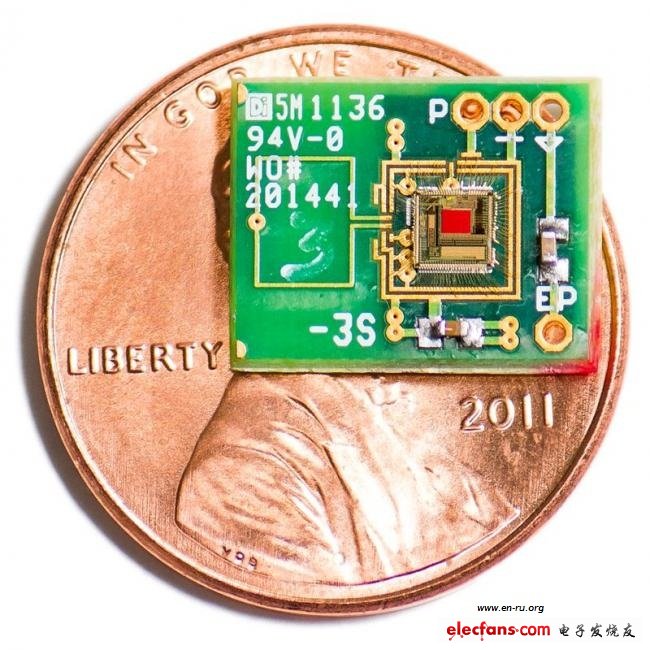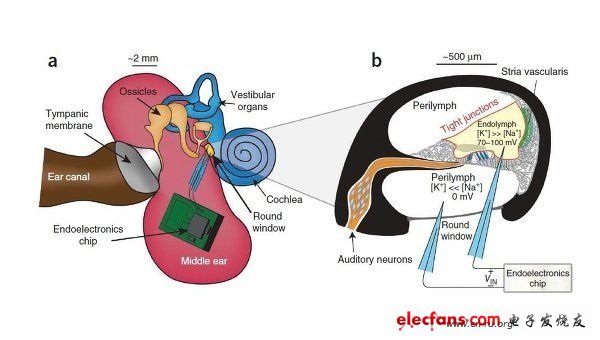Deep inside the inner ear of a mammal is a natural battery: a small chamber filled with ions that generates voltage to drive nerve signals. According to the physicist organization network recently, researchers from the Massachusetts Institute of Technology, Massachusetts Eye and Ear Hospital and other units have proved for the first time that this "battery" can power implanted electronic devices without harming hearing. Devices implanted into the inner ear can be used to monitor biological activity, such as hearing sounds, imbalances, or response to treatment. Ultimately, the implanted device itself can be developed into a treatment. Related papers were published in the recently published "Nature · Biotechnology" magazine.
"60 years ago we knew there was a 'battery' that was very important for hearing, but no one would use it to power electrical appliances," said Constantia Stankovic, an ear surgeon at the Massachusetts Eye and Ear Hospital.

The ear can convert the mechanical pressure-the vibration of the eardrum-into electrical signals that the brain can process, and the bio-battery is the power source of the signal current. The battery compartment is located in a place called the cochlea in the inner ear, separated by a layer of membrane, where some cells have been specialized into a dedicated ion pump. On the other side of the membrane are unbalanced potassium and sodium ions, combined with the special arrangement of these cell pumps, a voltage is generated. Although the voltage here is the highest in the body (at least for a single cell), it is still very low, and in order not to disturb hearing, the available current can only account for a small part of it.
The low-power chip developed by the team of Anasa Chandrakashan, a researcher at the MIT Microsystems Technology Laboratory, solves this problem. They also installed an ultra-low power wireless transmitter on the chip to obtain the detected data. Because the voltage of the bio-battery is unstable, a power conversion circuit is also installed on the chip, just like a box-type converter at both ends of the power line of a general electronic device, which can gradually charge. The charging time is generally 40 seconds to 4 minutes, which can power the transmitter. The signal frequency itself indicates the electrochemical nature of the inner ear.

In the experiment, the researchers implanted electrodes on both sides of the guinea pig inner ear biocell membrane, and connected a low-power chip to the electrodes. The chip is left outside the guinea pig, but it is small enough to fit into the middle ear cavity. After implanting the electrode device, the guinea pig responded normally during the hearing test. The device can also transmit data wirelessly and report the chemical conditions of the ear and external receiver.
Cliff Megelion, chairman of the Department of Otolaryngology at Case Western Reserve University, said the study has three possible applications: cochlear implantation, disease diagnosis, and implanted hearing aids. The low voltage of the cochlea itself generates current, which turns it into a power source for powering electronic devices implanted in the cochlea. In addition, if voltages in various disease states can be detected, a diagnostic calculation method may be developed based on this current output deviation.
Industry Applications
|
Pharmaceutical Portable Semiconductor Electronic Laboratory |
Optics Plastics/Injection Mold Military/Defense Research/Biomedical/Biotech |
Health Science Manufacturing/Industrial Aerospace Medical Solar/Alternative Energy |
Pharmacy FDA Validatable Government Agencies Universities |
Cleanroom Products
Modular cleanooms/dryrooms, load bearing wall and top desk panels, recirculation fan cabinets and custom air handlers, softwall Cleanrooms, containment modules, HEPA Filter systems, portable, mobile cleanrooms, positive and negative pressure P3 containerized cleanrooms, cleanroom equipment and furnishings.
Cleanroom Services
Cleanroom consultation and design services, environmental system audits, cleanroom/dryroom design, laboratory upgrades and modifications.
Modular Cleanroom Construction
Clean Air Technology's prefabricated, modular wall and deck systems are designed to provide rapid, clean installation. These modular cleanrooms/dryrooms feature an aesthetic appearance and long term flexibility to change as your process requirements evolve.
Flush fitting, factory installed windows and utilities enhance cleaning. The load-bearing, double wall design, modular top deck panels and sealed negative pressure plenum assure optimum performance and longevity.
Fan Cabinets
The air handlers and recirculation fan cabinets designed for quiet operation and durable, efficient performance in cleanrooms, dryrooms, and other demanding environments.
Unlike batch-built units, our cleanroom air handlers are all custom built and equipped with drive assemblies and components that are selected for your specific applications.
a single source, turnkey cleanroom supplier serving the following market segments: pharmaceutical, semiconductor, electronics, optics, military/aerospace, medical, pharmacy, FDA validatable, manufacturing/industrial, packaging, health sciences, government.
Cleanrooms
Cleanroom Systems,Iso Clean Room,Clean Room Design,Modular Clean Room
Dongguan V1 Environmental Technology Co., Ltd. , https://www.v1airpurifier.com
